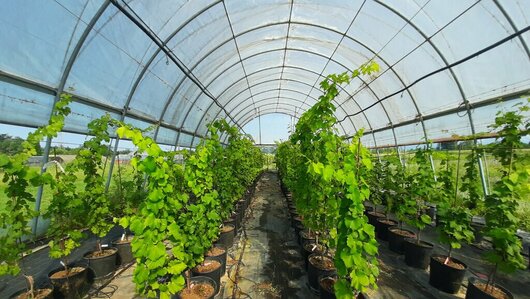State of the Art
Grape production is among the most important farming activities in Europe, accounting for 10% of the agricultural production value.
Climate change has challenged to reduce water consumption and enhance fertilization efficiency encouraging to develop
management alternatives for quality agronomic production. However, climate change is threatening the
sustainability of European viticulture. Beside water, N is considered the most important mineral nutrient in
controlling both grape yield and quality, and soil N availability and N plant demand is strongly influenced by soil water availability.
Vitis vinifera cultivars have different sensitivity to climatic variations and vary in the hydraulic strategy adopted to cope with water
shortage. Vine response to water availability can be simplified using a phenomenological scale
ranking species from isohydric to anisohydric. This terminology describes seasonal/daily water
potential (Ψ) homeostasis or the Ψ leading to stomatal closure. However, the iso/anisohydric paradigm has not unveiled cultivars
response to water stress and which behavior represents better adaptation to drought remains unclear.
Research progress to unravel the underlying mechanisms of resistance to water deficit should rely on holistic approaches that
integrate multiple physiological parameters and adopt the use of molecular markers to describe more accurately, and better predict,
varietal responses to water deficit. We chose two of the most world-wide cultivated varieties: Grenache – known for its tolerance to
drought and to have a near-isohydric behavior in case of water stress – and Cabernet Sauvignon – less tolerant
than Grenache and showing a generally anisohydric response to water stress.

However, achieving sustainability objectives while guaranteeing the expected food production will not be easy. Because of this, there is a strong expectation of innovative solutions.
Controlled water deficit irrigation is a strategy to increase water use efficiency and improve the accumulation of secondary
metabolites in grape berries. Water stress upregulates the expression of several genes involved in the biosynthesis of polyphenols
and particularly of anthocyanins, and terpenes biosynthesis is enhanced under water deficit. These secondary metabolites are responsible for wine quality, hence techniques that increase their concentration
in the grapes are greatly valued. However, severe water stress might be detrimental for vine yield and the economic vineyard
profitability; as consequence, it is important to optimize vineyard irrigation by the desired wine styles and the
grape marketplace.
The movement of nutrients in the soil solution is dependent on water flow through the soil-root pathway, therefore the reduction of
soil moisture can potentially limit nutrient acquisition by plants. It could be speculated that nutrient acquisition
efficiency could be improved by lowering fertilization rates under limited water availability. Nitrogen (N) is the mineral nutrient most
taken up by plants, and its absorption and distribution within the plant must be coordinated for optimal growth and development. Nitrogen influences grape yield and quality, but the molecular mechanisms involved in N
acquisition from soil to roots and its regulation under water deficit in the grapevine are still poorly investigated. Nitrate (NO3-) and ammonium (NH4+) move in the soil solution from
soil pores into plant roots mainly through mass flow and diffusion, respectively. Soil N availability and N plant demand is strongly
influenced by soil water availability that may also limit microbial activity modifying differently the rates of
ammonification and nitrification. So far, research has considered the separate effects of water management or N fertilization but has neglected to explore their interactions.
To deal with unfavourable conditions of water and N availability, plants change root architecture, uptake capacity and exudation into
the rhizosphere, with these responses depending on the plant species/ecotype and on the specific environmental conditions.
